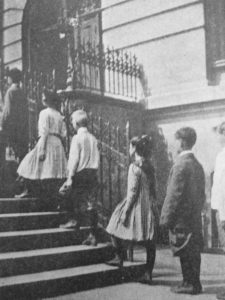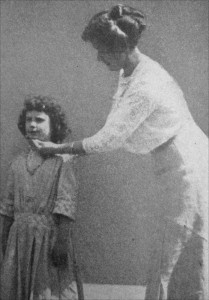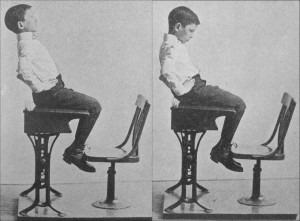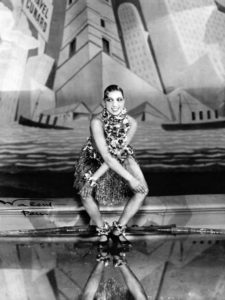The Unknown History of Posture Training in Public Schools 1913-1950
Mandatory schooling laws lead to a heated posture debate: 1880s
At the beginning of the 20th century controversial new laws started requiring school attendance for all children, sparking a heated debate. Advocates asserted the importance of schooling to close the wealth gap, to give opportunities to former child laborers, and to Americanize immigrants; while opponents railed against the assault on the rights of families to raise children according to their own methods.
During this turbulent transition, every element of schooling came under public scrutiny. The nature of the classroom required children to “distort” their bodies by sitting in desks for 6 hours a day; a behavior, it was argued, that was unnatural and dangerous. Opponents contended that children need exercise and freedom in order to thrive, that the new standard went against the very essence of childhood. School was widely thought to be damaging the bodies of children, and the worst part was that parents had no say in the matter.
The evils of prolonged sitting
The school desk itself was heavily demonized. If it is too low the child is forced to slump, and if it is too high the child hunched the shoulders. Great attention was paid to the measurements of desks and volumes were written about the importance of a proper fit in order to preserve the physical integrity of a growing body.
Books such as The School and Industrial Hygiene further condemned the design of school furniture, claiming that desks were responsible for a variety of health problems ranging from near-sightedness to “deformity of the spine”. It asserted that 83-92% of students suffered from spinal deviations and posture problems as a result.
Schools combat the problem: Early 1900s
Schools sought to change their tarnished public image by zealously confronting the posture problem. They did not want to be seen as the destroyers of children’s health, so they started introducing standardized posture evaluations and corrective programs for elementary school children.
The physical fitness of students became a paramount concern. Any and all postural problems were attributed to effects of school, requiring administrators to assume responsibility for the posture of every single child. Fears that we were producing a generation of slothful, feeble children jeopardized the school system as a whole. Entire regions of the country were already ignoring mandatory education laws and schools were on the offensive about the posture issue.
While the posture movement was ahead of it’s day in many respects, it is impossible to separate it from the teaching tactics of the time. Corporal punishment was the discipline method of choice in many schools, and completely legal in every state except New Jersey until 1971. The literature on posture correction did not encourage physical punishment, but a fair amount of humiliation seems to have been inflicted on those who fell short of the standards. Ironically, educators were told that they must not embarrass children even though a number of motivation techniques would be considered to be harsh, if not abusive, by today’s standards.
Despite some of the questionable motivation tactics, the fact remains that the emphasis on ergonomics in the classroom
would have benefitted a great many children. It is easy to dismiss these teachings as bizarre, but upon closer inspection these long-forgotten practices are incredibly forward thinking. Children were exposed to a sort of physical therapy before bad habits turned into chronic problems. Exercises to even out dangerous strength imbalances that pulled the body out of alignment were a daily part of the school day. Physical fitness programs were specifically geared toward the individual’s needs, resulting in a generation that put great care into the prevention of repetitive injuries.
The American Posture League and standardized posture testing: 1913
The American Posture League was born in 1914, prompting it’s well-meaning founders Jessie Bancroft and Dr. Elisa Mosher to travel far and wide, lecturing school officials about everything from record keeping and standardization to corrective exercises and motivational methods.
Detailed methods of observing, testing and measuring all elements of posture were implemented in schools across the nation. Children were routinely photographed from all angles and carefully observed while sitting, standing and walking. Some were even stripped down to their underwear and encouraged to examine their own posture in full-length mirrors.
In her 1913 book, The Posture of School Children, Jessie Bancroft outlined methods for evaluating and correcting everything from a forward head to a pigeon toe. She developed the famous “triple test”, which carefully regulated posture evaluation and lead to the development measurable results. Now the effectiveness of posture reform efforts could be tracked widely and consistently throughout the country.
Bancroft suggested that classroom teachers administer the triple test on a monthly basis, recording the results and encouraging students to achieve higher scores each time. Administering the triple test to the class took about 20 minutes for efficient, experienced teachers.
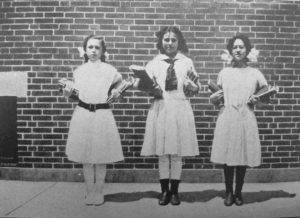
These girls demonstrate the healthy practice of carrying equal weight in each arm to avoid distorting the spine. 1913
The American Posture League’s mission ran deeper than simply helping children to sit properly at their desks; it strove to improve the overall health of the entire nation. They believed that erect posture was needed to achieve full health. “In good posture, also, better circulation, respiration, and digestion keep the stores of energy and sense of well-being at a higher level, and the efficiency and even the spirits of the individual are thereby placed on a loftier plane.”
Jesse Bancroft said that perfectly poised posture requires very little effort to maintain. A poor standing position puts strain on the muscles and ligaments and energy is wasted. Fatigue and inertia set in and the general sense of wellness is reduced. “Moreover, with this lowered tone of the organism the power of resistance to disease is decreased. The germs of tuberculosis and other infectious and contagious diseases will find lodgment and will flourish in a body whose general tone and power are thus reduced, as they could not in one whose machinery is working to better advantage.”
What happened?
Despite the pervasiveness of postural instruction in the physical education movement, the influence of popular culture proved more powerful. The flapper generation took this casualness to the extreme as an act of rebellion against authority. Upright posture was associated with rigidity and stuffiness. It conveyed a social awkwardness and was used to mock targets of ridicule
Lounging in front of the radio allowed pseudo human interaction without being seen or corrected. Dark movie theaters, and later television would add opportunities for slouching without notice.
By the 1960s the posture craze had come to an end. Popular culture had one. The American postural he closed in 1943, most school posture clinics closed in the 1950s, and Vasser stopped its fundamentals course in the 60s. Posture in yearbook photos continued to devolve as students began to increasingly slump, lean, and relax (cited from The Thistle, Carnegie Mellon university archives 1906-1964).


